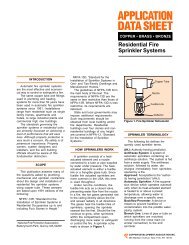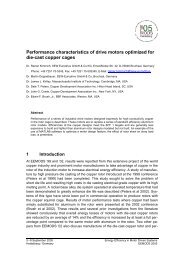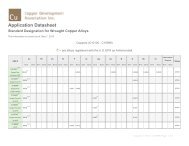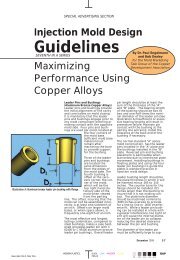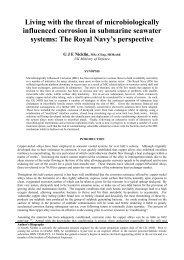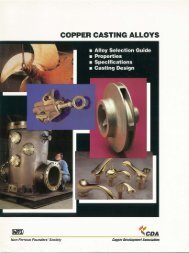Stress corrosion crack<strong>in</strong>g testsU-Bend tests were conducted accord<strong>in</strong>g to ISO 7539-3 st<strong>and</strong>ard (ref 13).Tests parameterswere selected with regard to those def<strong>in</strong>ed previously to estimate CuAl9Ni3Fe2 SCCsusceptibility <strong>in</strong> <strong>natural</strong> <strong>sea</strong> <strong>water</strong> <strong>and</strong> polluted stagnant <strong>sea</strong> <strong>water</strong> with aqueous ammonia[14]. Specimens were bent to a bend<strong>in</strong>g radius <strong>of</strong> 14 mm. Test environments chosen were<strong>natural</strong> <strong>sea</strong> <strong>water</strong> <strong>and</strong> stagnant <strong>sea</strong> <strong>water</strong> added with two concentrations <strong>of</strong> aqueousammonia: 170 ppm (0.01 mol/l) <strong>and</strong> 1700 ppm(0.1 mol/l). Cracks were <strong>in</strong>deed observed onCuAl9Ni3Fe2 <strong>in</strong> these conditions after respectively 1000 h <strong>and</strong> 120 h <strong>of</strong> test duration(ref14). Each specimen was duplicated <strong>and</strong> two test durations were selected, 1000 hours <strong>and</strong>5000 hours (four specimens tested <strong>in</strong> each condition).RESULTS AND DISCUSSION<strong>Corrosion</strong> parameters <strong>in</strong> <strong>natural</strong> <strong>sea</strong> <strong>water</strong> (absence <strong>of</strong> critical <strong>in</strong>terface)Eoc measurements <strong>of</strong> Nibron compared to CuNi10Fe1Mn are given <strong>in</strong> Figure 3. In <strong>natural</strong><strong>sea</strong> <strong>water</strong>, Nibron Eoc is ma<strong>in</strong>ta<strong>in</strong>ed around -250 mV vs. SCE over a period <strong>of</strong> time <strong>of</strong> aboutone month. Then, Eoc <strong>in</strong>creases to -70 mV vs. SCE after 2 months <strong>of</strong> test. The triplicatespecimens <strong>in</strong> test give the same results.Rp measurements <strong>of</strong> Nibron , shown <strong>in</strong> Figure 4, confirms this tendency to corrosion<strong>in</strong>itiation with an <strong>in</strong>itial value <strong>of</strong> 5000 to 10 000 Ohm decreas<strong>in</strong>g to between 10 <strong>and</strong> 300Ohm after 2 months <strong>of</strong> exposure to <strong>sea</strong> <strong>water</strong>. Nibron specimens exam<strong>in</strong>ations, presented <strong>in</strong>Figure 5, shows green oxidation products significant <strong>of</strong> corrosion <strong>in</strong>itiation. The meancorrosion rate is nevertheless low around 18 µm/year. Pitt<strong>in</strong>g corrosion is observed but thepit depths are too low to be estimated. After one month <strong>of</strong> exposure to <strong>natural</strong> <strong>sea</strong> <strong>water</strong>,anodic polarization curves, <strong>in</strong> Figure 6, exhibit no actual passivation threshold, the currentdensity <strong>in</strong>creases from 10 -7 A/cm 2 to about 10 -5 A/cm 2 up to a potential <strong>of</strong> -50 mV vs. SCE.Over this potential, anodic current sharply <strong>in</strong>creases to 10 -3 A/cm 2 . If Nibron is compared tothe classical CuNi10Fe1Mn, mean corrosion rate could be considered similar respectively18 µm/year <strong>and</strong> 15 µm/year but Nibron could have a higher tendency to pitt<strong>in</strong>g <strong>in</strong> <strong>natural</strong><strong>sea</strong> <strong>water</strong>. Eoc <strong>and</strong> Rp measurements confirm this different <strong>behaviour</strong>. CuNi10Fe1Mnpresents <strong>in</strong>deed a steady potential <strong>and</strong> Rp with time, respectively -200 mV vs. SCE <strong>and</strong>2000 Ohm as Nibron shows an <strong>in</strong>crease <strong>in</strong> potential over -100 mV vs. SCE <strong>and</strong> a decrease <strong>in</strong>Rp under 100 Ohm after 2 months <strong>of</strong> exposure to <strong>sea</strong> <strong>water</strong>.In conclusion, Nibron could be considered a bit more susceptible to corrosion <strong>and</strong> especiallylocalised corrosion than CuNi10Fe1Mn <strong>in</strong> <strong>natural</strong> <strong>sea</strong> <strong>water</strong>.Eoc measurements <strong>of</strong> A45 compared to the NAB CuAl9Ni3Fe2 are given <strong>in</strong> Figure 7.Similar phenomenon is observed on both <strong>alloys</strong>, that is an <strong>in</strong>crease <strong>in</strong> potential from -250mV vs. SCE to -90 mV vs. SCE after 2 months <strong>of</strong> exposure to <strong>sea</strong> <strong>water</strong>. At the same time,Rp shown <strong>in</strong> Figure 8, presents similar evolution with a decrease from a steady value <strong>of</strong>3000 Ohm to 100 Ohm after 2 months <strong>of</strong> test. Specimen exam<strong>in</strong>ations reveal a meancorrosion rate <strong>of</strong> 37 µm/year with a localised corrosion observed near the coated electricconnection evaluated at 1.3 mm/year, the max. depth be<strong>in</strong>g <strong>of</strong> about 150 to 300 µm. Similarobservations are made on CuAl9Ni3Fe2. Anodic polarization curves performed on A45 <strong>and</strong>CuAl9Ni3Fe2 , <strong>in</strong> Figures 9 <strong>and</strong> 10, are very similar. No actual passivation thresholds areobserved <strong>in</strong> both cases. For A45, current densities <strong>in</strong>crease slowly from 10 -6 A/cm 2 to 10 -54
A/cm 2 between -220 mV vs. SCE <strong>and</strong> -100 mV vs. SCE. Then, over – 100 mV vs. SCE ,current densities sharply <strong>in</strong>crease to 10 -3 A/cm 2 .In conclusion, electrochemical <strong>behaviour</strong> <strong>of</strong> A45 <strong>and</strong> CuAl9Ni3Fe2 are very similar with ahigher tendency to localised corrosion <strong>of</strong> these both <strong>alloys</strong> compared to Nibron orCuNi10Fe1Mn.Influence <strong>of</strong> sulphides pollution on corrosion parametersWith suphides pollution, Eoc measured on Nibron shown <strong>in</strong> Figure 3 <strong>in</strong>creases from - 250mV vs. SCE to -70 mV vs SCE after 2 months <strong>of</strong> test, as it was observed <strong>in</strong> <strong>natural</strong> <strong>sea</strong><strong>water</strong>. At the same time Rp , <strong>in</strong> Figure 4, decreases to 100 Ohm. Specimen exam<strong>in</strong>ationafter the test, reveals an important green oxides deposit as shown <strong>in</strong> Figure 5 with a meancorrosion rate estimated about 49 µm/year. Nibron anodic polarization curve with sulphidespollution is very similar to those <strong>of</strong> CuNi10Fe1Mn. Anodic current, <strong>in</strong> Figure 6, sharply<strong>in</strong>creases to 10 -4 A/cm 2 for a potential between -100 mV vs. SCE <strong>and</strong> -30 mVvs.SCE.In conclusion, with sulphides pollution, Nibron presents a comparative <strong>behaviour</strong> toCuNi10Fe1Mn. Compared to results <strong>in</strong> <strong>natural</strong> <strong>sea</strong> <strong>water</strong>, mean corrosion rates are <strong>in</strong>creased<strong>and</strong> affected areas are spread all over the exposed surface <strong>in</strong> both cases.Influence <strong>of</strong> ammonia pollution on corrosion parametersWith ammonia pollution, A45 Eoc, shown <strong>in</strong> Figure 11, decreases from – 250 mV vs ECS to-350 mV vs. ECS. This decrease <strong>in</strong> potential was checked on Pt Electrode. The samephenomenon is also observed on CuAl9Ni3Fe2 (see Figure 12). Specimen exam<strong>in</strong>ationsafter the tests reveal a superficial corrosion with no significant pitt<strong>in</strong>g. The mean corrosionrates for A45 <strong>and</strong> CuAl9Ni3Fe2 are respectively 13 µm/year <strong>and</strong> 16 mm/year. Anodicpolarization curves performed on A45 <strong>and</strong> CuAl9Ni3Fe2, <strong>in</strong> Figure 9 <strong>and</strong> 10 reveal asignificant <strong>in</strong>crease <strong>in</strong> current between -150 mV vs. SCE <strong>and</strong> – 250 mV vs. SCE <strong>in</strong> <strong>sea</strong> <strong>water</strong>with ammonia pollution. The current densities reach 7.10 -5 A/cm 2 .In conclusion, these tests reveal the potential risk <strong>of</strong> galvanic coupl<strong>in</strong>g between a surfacepolluted with ammonia <strong>and</strong> a large surface <strong>in</strong> unpolluted <strong>natural</strong> <strong>sea</strong> <strong>water</strong>.Parameters <strong>of</strong> crevice corrosion <strong>in</strong>itiation (Static tests) <strong>in</strong> <strong>natural</strong> <strong>sea</strong> <strong>water</strong>Tests conducted on Nibron, under – 70 mV vs ECS <strong>in</strong> Figure 13, lead to a high currentaround 10 -3 A/cm 2 after 100 hours <strong>of</strong> test. A uniform corrosion is observed, localised out <strong>of</strong>the crevice <strong>in</strong>terface. CuNi10Fe1Mn presents exactly the same phenomenon with lowercurrent about 5. 10 -5 A/cm 2 under a potential <strong>of</strong> -75 mV vs.ECS.On A45, the current measured under – 100 mV vs SCE is 10 -5 A/cm 2 after 100 hours <strong>of</strong> test.Then, it <strong>in</strong>creases gradually to 10 -4 A/cm 2 (see Figure 14). <strong>Corrosion</strong> is observed out <strong>of</strong> thecrevice <strong>in</strong>terface but localised at the edge <strong>of</strong> the gasket. A45 <strong>and</strong> CuAl9Ni3Fe2 show a verysimilar <strong>behaviour</strong>.In conclusion, the various materials tested show a certa<strong>in</strong> susceptibility to crevice corrosion.In each case, this corrosion is localised out <strong>of</strong> the crevice <strong>in</strong>terface <strong>and</strong> close to the gasketedge <strong>in</strong> the case <strong>of</strong> NAB.5



